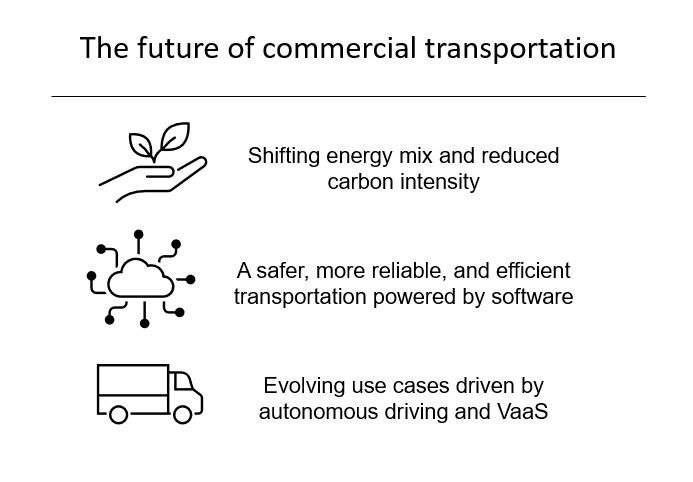
Advanced technology will pave the way to exceed what was previously thought possible.
The commercial transportation industry faces rapidly changing regulations and evolving customer needs. Cummins examines the future of commercial transportation, and indicates that it will be shaped by three perspectives: a shifting energy mix, innovations in software, and evolving use cases driven by autonomous driving and vehicle-as-a-service (VaaS).
Within cities, the need and benefit for decarbonization is the highest. Cities also offer two circumstances to spur decarbonization: a dense population of transportation assets that share a common infrastructure and the use-cases that are easier to decarbonize, such as last-mile delivery.
For commercial transportation, the future of energy can be summed up simply: zero carbon emissions, well-to-wheel. This is the destination, driven by societal pressure and environmental needs. This will require a shift in energy mix, and the journey to decarbonize commercial transportation will be rooted in a comprehensive technology roadmap with three primary components: zero emissions technologies such as battery electric and fuel cell electric; low to zero carbon fuels; and fuel agnostic powertrain platforms.
The 2020s will be shaped by two trends: those that will make the leap to zero, and the rise of low to zero carbon fuels. Busses that operate in urban areas are leading the sector in making the leap to zero carbon emission solutions, at the tail pipe. Transportation emissions will decrease by ~1.4% in the U.S. when the majority of buses switch to zero carbon emission technologies. There is another overlooked benefit of busses leading the way towards zero carbon emissions: fast-tracking innovations. As more of our bus partners choose zero-emission technologies, we find innovative solutions to meet their needs. These learnings ready zero carbon emission technologies for other transportation use-cases sooner. When it comes to the rise of low to zero carbon fuels, renewable natural gas, biodiesel blends, and hydrogen will lead the way, and internal combustion engine technology will see improved efficiencies. Meanwhile, we also plan to make our new engines compatible with increasing blends of low carbon fuels. During this era, hydrogen engines may also gain traction among line haul trucking. The key to hydrogen adoption will be the cost parity of hydrogen to diesel and infrastructure for refueling.
In the 2030s, we will begin to see a marked scale-up of new technologies and fuels. Battery-electric and fuel cell electric solutions will be viable for more use cases, especially with urban vehicles. Meanwhile, alternative fuels such as renewable natural gas (RNG), hydrogen, and biodiesel blends could have global footprints. At a regional level, varying local availability of different feedstocks will keep less popular low to zero carbon fuels in play. For bio-derived fuels, an interesting dynamic could play out during this decade. Given these limited stock bio-derived fuels could be the only viable path to decarbonize aviation, we could likely see a limited use of them in road transportation. The 2030s will also be the decade we will learn more about the viability of synthetic fuels for commercial transportation. Cost, availability, and efficiency of energy pathways will be three of the key factors to watch-out.
In the 2040s, electrification will become more viable even for today’s hard-to-electrify use cases. For example, heavy-duty and line-haul trucks are challenging to electrify today, mainly because the energy density of today’s batteries and limited recharging infrastructure would interfere with the truck’s job. This may become less and less of an obstacle as technology and infrastructure continue to advance. As the vehicle electrification eliminates tank-to-wheel emissions, well-to-tank emissions will get increasing spotlight. The good news is, by 2040, renewable electricity is forecasted to account for over 60% of our electricity1. To get there will take doubling the investments in electricity industry, as a share of GDP, towards $1.2 trillion a year by the second half of the 2020s, and strong public and private partnerships.
This article is to be continued in the first issue of August. Source